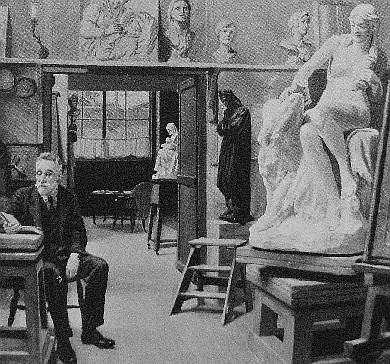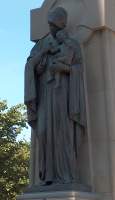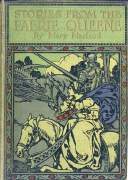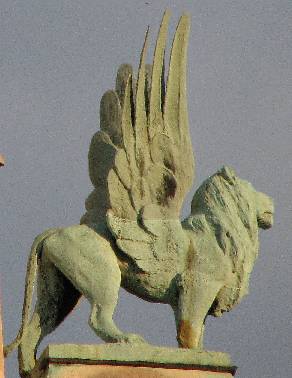Arthur George Walker RA (1861-1939)
Walker in his studio with various works, including Circe.
The sculptor AG Walker fits in the New Sculpture movement, and among his sculptural works are some important
things. Most remarkable is his work for the former Church of the Agapomene in Stamford Hill, now used by the Ancient Catholic
Church. This ambitious
ensemble includes a variety of large bronze and stone sculptures of winged creatures and angels. The bronze work, set against
the skyline, is impressive by its silhouette rather than a grandeur of modelling, but the stonework, at ground level, shows a
solidity and strength even in its worn condition, and shows the capability of the artist.
Walker has several other public sculptures. In London, on the exterior of the Victoria and Albert Museum, he has two
figures William Morris and Roger Payne. His Florence Nightingale
in Waterloo Place, subordinate to the larger Crimea Memorial which it flanks, has the subject careworn rather than heroic.
Walker won the commissions for a number of war memorials. At Limehouse he has (or had: I have not spotted it) one with a
standing Christ, and six versions of a standing infantryman, including at Wolverhampton, in Heath Town Park, and in Chesham, Bucks. And in Derby is his World War 1 Monument, showing a grieving woman and
infant, the liveliness of the latter, while indicating renewal and new life, giving a certain pathos (he made another rather
similar maternal figure entitled Humanity, with a more conventional baby). Among his religious works, he has
versions of the Virgin and Child in Llandaff Cathedral and Wells Cathedral, and a John the Baptist,
location unknown to me.
Derby Memorial by Walker.
Walker s ideal figures are interesting. A delicately balanced leaning nude, called The Thorn; a
Circe seated on an affectionate boar, a male figure of a Youthful Faun, piping to a rabbit;
Cymon finding Iphegenia Asleep; and an expelled Adam and Eve called And they were afraid, made
in marble and bronze versions, the latter of which is in the Walker Art Gallery, Liverpool. All good things. His
females are slender but wide in the hip, and his males typically, though not always, sinuous rather than muscular. I should
mention his The Necromancer: Cleopatra and the Priest Harmachis, with the Queen sprawled in a chair and Harmachis,
with feral expression, crouched above and slightly behind her; an excellently composed group.
Walker also produced some plaques in relief, delicate things in low relief for memorials, or more three-dimensional things
such as the plaques around the base of the Florence Nightingale memorial and a couple of roundels at the Agapomene church.
In terms of portrait sculpture, Walker produced a range of busts in marble, and at least one in ivory, a figure of
Mrs Pankhurst, and an equestrian John Wesley, outside the Wesley Chapel (New Room) (the oldest
Methodist Church), Broadmead, Bristol - shown on this page.
Faerie Queen illustration.
Walker studied at the Royal Academy Schools, and exhibited his ideal sculpture, paintings, and later mostly plaques and
busts at that venue, over 80 works in all spanning from 1884 through to 1937. He drew book illustrations too, including
Stories from the Faerie Queene and other works by Mary Macleod pleasant and harmless rather than significant.
Apparently he also made mosaics, though I have not had the opportunity to see these. He was based in London, but had an
address in Dorset after 1933.
Sculpture by Walker on the Agapomene church.



